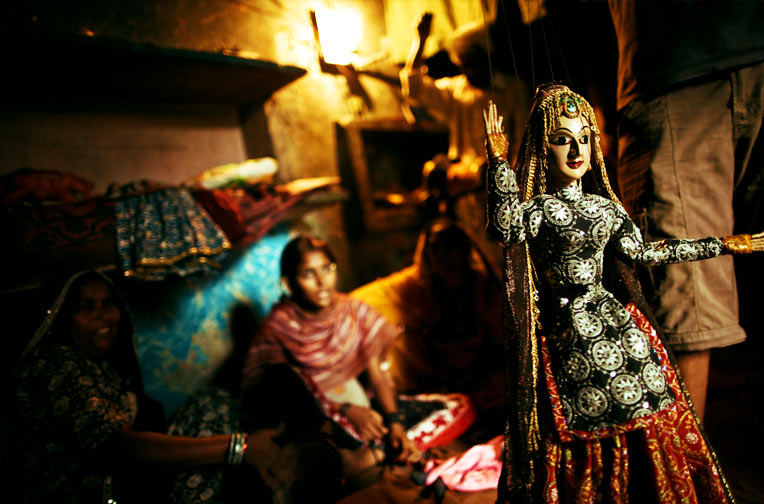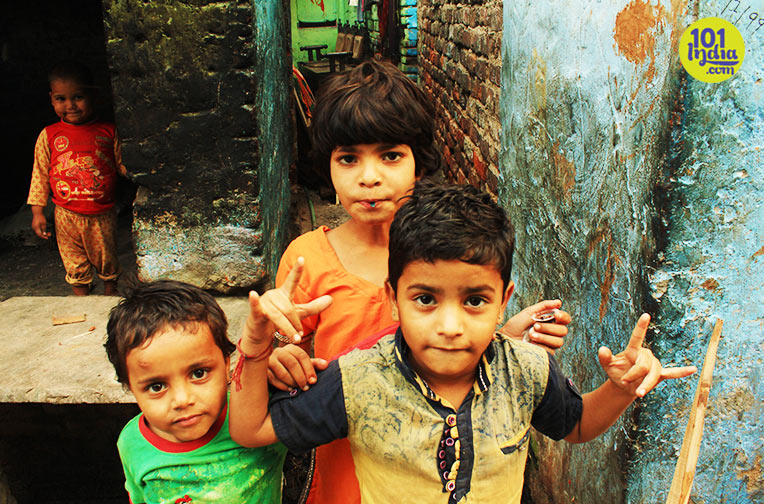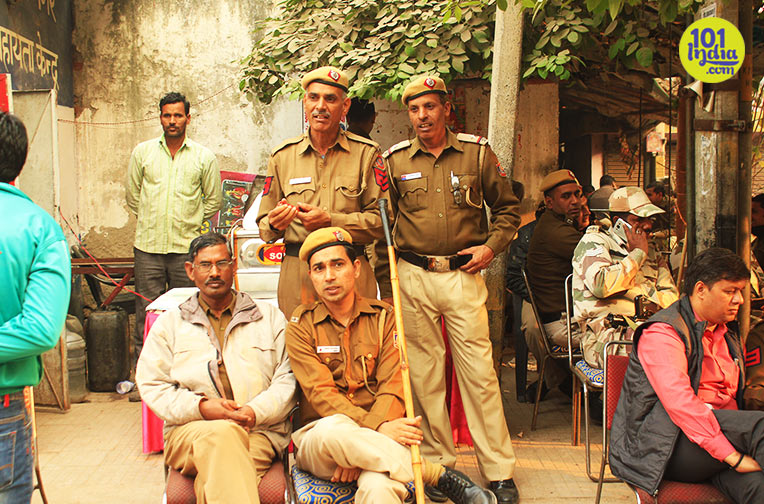My conversation with the puppeteers of this colony was cut short by a surprise visit.
The azure walls of the Bhat household in Delhi’s Kathputli Colony stand out on the main street running through the slum, inviting a fair share of inquisitive stares. A shutter holds back the street from spilling onto the patio where a large group of ladies usually huddle together at tea time for the daily gossip, and then to a tiny courtyard. Thin gutters lined across the walls, running into the main line right at the doorstep, form a drainage system. Deep inside the house lies the small family bedroom with a double mattress laid out on the floor, where I get invited to share a cup of tea with the man of the house.

A tiny settlement of travelling artists grew into the largest slum. Image source: AtlasObscura.com
Succeeding his father as head of the second generation of puppeteers from the Bhat family since the first few migrants from his village in Rajasthan settled in Delhi, Santosh Bhat is now a renowned artist both within and outside the bounds of the colony. Bala Bhat – Santosh Bhat’s father – was among the first spurts of tents that pitched themselves in a small patch in the Shadipur district nearly 50 years ago. A tiny settlement of travelling artists soon grew into the largest slum dwelling of street performers in Asia. The art of puppetry is one that travels back centuries along the Bhat family’s bloodline, he told me. To the Bhat’s, this is who they are and what they’re best at. It’s always been that way, and every member of the family has fallen in line.

An upcoming generation of performers
My first visit to the colony was just as I had envisioned it to be based on my previous knowledge. The stench of refuse and human waste breezed through narrow alleys between favela-like cement huts. Walking through the colony was a combination of dodging thin dark streams of sewage and stepping on unsuspecting toes. Common symptoms of a slum, I thought. But, it was the sound of the dhol that was peculiarly unique to this one. It seemed as if each step I took past a home along the street invited me into a fiesta of singing, or dancing. Kids had fashioned plastic oil containers, hanging around their necks, with cut-outs to serve as makeshift dhols, providing the ever-present percussion that serves as a soundtrack to the village. Venturing deeper into the colony would have you bumping into the masters of fire-eating, magic, acrobatics, woodcarving, and more.
The colony, the artists, and the arts
Historically, puppetry, or kathputli, is one of the oldest and most widespread performance arts native to the Rajputana region. Known to be nearly a thousand years old, the art of storytelling through a duet of music and marionette motions has been the medium of narrating old folk tales from the time of yore. These days, kathputli helps spread awareness on social causes; the Song and Drama Division, which Bhat has been a part of in the recent past helps with this.
There are barely any stages and takers left for the art, Bhat assured me. Puppetry’s charm has been reduced to only an intrigue in its archaic nature. When I inquired about how they could possibly make a living off of it, Bhat hints toward the negative. Folk and heritage festivals, the odd comic performance for children at fetes, and weddings, are some of the very few stages left for the marionette. But, I couldn’t sell short Bhat’s nimble expertise with animating the wooden doll if I tried. He’s performed his art for crowds in Mexico, Singapore, the Americas, and almost everywhere in between. He’s had people from all over the world come to him to learn his style of puppetry. He is after all one of the rare remaining experts of this historically significant art.

small>Puppetry is reduced to performances at weddings and children’s parties. Image source: tripwolf.com
Although Mr. Bhat’s two sons have actively displayed interest in kathputli kalakari, he fears there is no future in it for them. Much like Mr. Bhat himself, his sons picked up the art while accompanying him to his performances, at a very young age. Mr. Bhat recounts on he, himself after watching his father perform on various stages, would pester him to teach him the art. A family tradition that is still very alive.

Mr. Bhat flaunting his lady love
Could the supposed lack of takers lead to an extinction of the art? Perhaps, not. But, it’s definitely not encouraging any security to its preservation from Mr. Bhat’s perspective. We were still in the midst of the gloom created by our conversations about a relocation battle, and an existential crisis eating away at his soul, when Mr. Bhat finally unveiled his most beautiful puppet to me. A child-like pride in his voice broke the tension as he told me he had created her himself. Everything from the carving of the wood, to the stitching of the lady’s dress, and the intricate artwork that gave her life, was a product of Mr. Bhat’s labour and guidance. A lady dancer clad in a gold and black dress, with flawless design, mustered a small performance for me. For the first time that evening Mr. Bhat’s sullen eyes lit up as he carefully tethered the ball of strings flowing out of the puppet onto his finger tips, and seamlessly created mesmerizing movements. He clearly still loves what he does, and evidently, is one of the best at it.
Eviction and redevelopment go hand-in-hand
In 2008, discussions regarding the possible redevelopment of the slum inevitably led to the beginning of an uncomfortable dialogue centred around coerced evictions between the state authorities and the residents. But it was this year, 2016, during the late hours on the night of December 22, that the police had begun barricading and setting up post in the colony. By the time the next two days had passed, the post turned into a small platoon’s station.

Cops. 'In case' things went sour
“They’re just here in case things go bad,” Mahesh Bhat, Santosh’s brother said, giving me an explanation I never asked for. He went on to tell me how the more prominent families of the village were rejoicing signing DDA’s agreements over their relocation to the transit camp in Anand Parbat, which by popular opinion is considered to have far worse living conditions than the slum itself. A deal Mr. Bhat is willing to take as he puts his faith into the developers who promise high-rises and malls, and more importantly homes for the residents in the area.

“The DDA can take this land over their dead bodies”
The DDA in action
But, as I spoke to more locals around the tent the DDA had set up, where the contracts were being filed, the supposed ‘agreements’ over the eviction started to seem more like coercion. This, indicated also by the fact that I was asked to leave the premises by one of the more senior Delhi Police officials. Evidently distressed, a whole mass of inhabitants gathered around me and were quick to recount how they’d had cops tell them that once the ball on the project was set rolling, the houses would be demolished whether the locals agreed with it or not. The residents seemed to be split when it came to their testimonials on how peaceful this discussion really is. While the more influential, and pro-redevelopment, families like the Bhats blamed the “less intelligent” folk for not allowing the colony to progress, another great majority cried foul play and possible forceful eviction. Either way, the sight of so many cops stationed in one spot, for once, was most unsettling.

By now this should count as an army
For now, Santosh Bhat has agreed with the DDA over the eviction, and looks forward to having his own home once his tenure at the transit camp is over. A tenure that’s been promised to last no more than two years. The DDA seem to be pursuing the forthcoming project aggressively, and my fear is for those who do not agree with it. How many from this community of artists will be given a new life, and how many rendered homeless, is something we might realize only once the worst has passed.
With the coming of the police, and the DDA, Mr. Bhat had become increasingly unavailable, and so our conversation about the future of puppetry remains unfinished.
Disclaimer: The views expressed in this article are independent views solely of the author(s) expressed in their private capacity and do not in any way represent or reflect the views of 101India.com.
By Aditya Varma
Cover photo credit: newslookup.com
How A Mythical Deity Became The Most Revered God In History
Dev Deepawali Celebration By Bal Brahmachari Kids Of Varanasi
All Access Mumbai With Milind Deora x JIO
Promoted Content by Outbrain |




Subscribe to our Newsletter. Your inbox will get all our latest stories and annoucements.